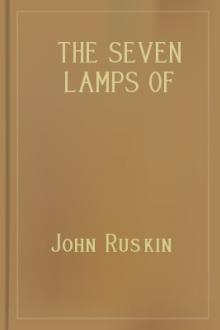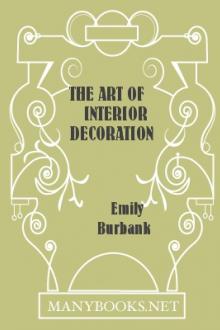The Seven Lamps of Architecture, John Ruskin [room on the broom read aloud .txt] 📗

- Author: John Ruskin
- Performer: -
Book online «The Seven Lamps of Architecture, John Ruskin [room on the broom read aloud .txt] 📗». Author John Ruskin
XX. But it will be said that much of the best wooden decoration of the middle ages was in shop fronts. No; it was in house fronts, of which the shop was a part, and received its natural and consistent portion of the ornament. In those days men lived, and intended to live by their shops, and over them, all their days. They were contented with them and happy in them: they were their palaces and castles. They gave them therefore such decoration as made themselves happy in their own habitation, and they gave it for their own sake. The upper stories were always the richest, and the shop was decorated chiefly about the door, which belonged to the house more than to it. And when our tradesmen settle to their shops in the same way, and form no plans respecting future villa architecture, let their whole houses be decorated, and their shops too, but with a national and domestic decoration (I shall speak more of this point in the sixth chapter). However, our cities are for the most part too large to admit of contented dwelling in them throughout life; and I do not say there is harm in our present system of separating the shop from the dwelling-house; only where they are so separated, let us remember that the only reason for shop decoration is removed, and see that the decoration be removed also.
XXI. Another of the strange and evil tendencies of the present day is to the decoration of the railroad station. Now, if there be any place in the world in which people are deprived of that portion of temper and discretion which are necessary to the contemplation of beauty, it is there. It is the very temple of discomfort, and the only charity that the builder can extend to us is to show us, plainly as may be, how soonest to escape from it. The whole system of railroad travelling is addressed to people who, being in a hurry, are therefore, for the time being, miserable. No one would travel in that manner who could help it—who had time to go leisurely over hills and between hedges, instead of through tunnels and between banks: at least those who would, have no sense of beauty so acute as that we need consult it at the station. The railroad is in all its relations a matter of earnest business, to be got through as soon as possible. It transmutes a man from a traveller into a living parcel. For the time he has parted with the nobler characteristics of his humanity for the sake of a planetary power of locomotion. Do not ask him to admire anything. You might as well ask the wind. Carry him safely, dismiss him soon: he will thank you for nothing else. All attempts to please him in any other way are mere mockery, and insults to the things by which you endeavor to do so. There never was more flagrant nor impertinent folly than the smallest portion of ornament in anything concerned with railroads or near them. Keep them out of the way, take them through the ugliest country you can find, confess them the miserable things they are, and spend nothing upon them but for safety and speed. Give large salaries to efficient servants, large prices to good manufacturers, large wages to able workmen; let the iron be tough, and the brickwork solid, and the carriages strong. The time is perhaps not distant when these first necessities may not be easily met: and to increase expense in any other direction is madness. Better bury gold in the embankments, than put it in ornaments on the stations. Will a single traveller be willing to pay an increased fare on the South Western, because the columns of the terminus are covered with patterns from Nineveh? He will only care less for the Ninevite ivories in the British Museum: or on the North Western, because there are old English-looking spandrils to the roof of the station at Crewe? He will only have less pleasure in their prototypes at Crewe House. Railroad architecture has or would have a dignity of its own if it were only left to its work. You would not put rings on the fingers of a smith at his anvil.
XXII. It is not however only in these marked situations that the abuse of which I speak takes place. There is hardly, at present, an application of ornamental work, which is not in some sort liable to blame of the same kind. We have a bad habit of trying to disguise disagreeable necessities by some form of sudden decoration, which is, in all other places, associated with such necessities. I will name only one instance, that to which I have alluded before—the roses which conceal the ventilators in the flat roofs of our chapels. Many of those roses are of very beautiful design, borrowed from fine works: all their grace and finish are invisible when they are so placed, but their general form is afterwards associated with the ugly buildings in which they constantly occur; and all the beautiful roses of the early French and English Gothic, especially such elaborate ones as those of the triforium of Coutances, are in consequence deprived of their pleasurable influence: and this without our having accomplished the smallest good by the use we have made of the dishonored form. Not a single person in the congregation ever receives one ray of pleasure from those roof roses; they are regarded with mere indifference, or lost in the general impression of harsh emptiness.
XXIII. Must not beauty, then, it will be asked, be sought for in the forms which we associate with our every-day life? Yes, if you do it consistently, and in places where it can be calmly seen; but not if you use the beautiful form only as a mask and covering of the proper conditions and uses of things, nor if you thrust it into the places set apart for toil. Put it in the drawing-room, not into the workshop; put it upon domestic furniture, not upon tools of handicraft. All men have sense of what is right in this manner, if they would only use and apply that sense; every man knows where and how beauty gives him pleasure, if he would only ask for it when it does so, and not allow it to be forced upon him when he does not want it. Ask any one of the passengers over London Bridge at this instant whether he cares about the forms of the bronze leaves on its lamps, and he will tell you, No. Modify these forms of leaves to a less scale, and put them on his milk-jug at breakfast, and ask him whether he likes them, and he will tell you, Yes. People have no need of teaching if they could only think and speak truth, and ask for what they like and want, and for nothing else: nor can a right disposition of beauty be ever arrived at except by this common sense, and allowance for the circumstances of the time and place. It does not follow, because bronze leafage is in bad taste on the lamps of London Bridge, that it would be so on those of the Ponte della Trinita; nor, because it would be a folly to decorate the house fronts of Gracechurch Street, that it would be equally so to adorn those of some quiet provincial town. The question of greatest external or internal decoration depends entirely on the conditions of probable repose. It was a wise feeling which made the streets of Venice so rich in external ornament, for there is no couch of rest like the gondola. So, again, there is no subject of street ornament so wisely chosen as the fountain, where it is a fountain of use; for it is just there that perhaps the happiest pause takes place in the labor of the day, when the pitcher is rested on the edge of it, and the breath of the bearer is drawn deeply, and the hair swept from the forehead, and the uprightness of the form declined against the marble ledge, and the sound of the kind word or light laugh mixes with the trickle of the falling water, heard shriller and shriller as the pitcher fills. What pause is so sweet as that—so full of the depth of ancient days, so softened with the calm of pastoral solitude?
XXIV. II. Thus far, then, of the place for beauty. We were next to inquire into the characters which fitted it peculiarly for architectural appliance, and into the principles of choice and of arrangement which best regulate the imitation of natural forms in which it consists. The full answering of these questions would be a treatise on the art of design: I intend only to say a few words respecting the two conditions of that art which are essentially architectural,—Proportion and Abstraction. Neither of these qualities is necessary, to the same extent, in other fields of design. The sense of proportion is, by the landscape painter, frequently sacrificed to character and accident; the power of abstraction to that of complete realisation. The flowers of his foreground must often be unmeasured in their quantity, loose in their arrangement: what is calculated, either in quantity or disposition, must be artfully concealed. That calculation is by the architect to be prominently exhibited. So the abstraction of few characteristics out of many is shown only in the painter's sketch; in his finished work it is concealed or lost in completion. Architecture, on the contrary, delights in Abstraction and fears to complete her forms. Proportion and Abstraction, then, are the two especial marks of architectural design as distinguished from all other. Sculpture must have them in inferior degrees; leaning, on the one hand, to an architectural manner, when it is usually greatest (becoming, indeed, a part of Architecture), and, on the other, to a pictorial manner, when it is apt to lose its dignity, and sink into mere ingenious carving.
XXV. Now, of Proportion so much has been written, that I believe the only facts which are of practical use have been overwhelmed and kept out of sight by vain accumulations of particular instances and estimates. Proportions are as infinite (and that in all kinds of things, as severally in colors, lines, shades, lights, and forms) as possible airs in music: and it is just as rational an attempt to teach a young architect how to proportion truly and well by calculating for him the proportions of fine works, as it would be to teach him to compose melodies by calculating the mathematical relations of the notes in Beethoven's Adelaïde or Mozart's Requiem. The man who has eye and intellect will invent beautiful proportions, and cannot help it; but he can no more tell us how to do it than Wordsworth could tell us how to write a sonnet, or than Scott could have told us how to plan a romance. But there are one or two general laws which can be told: they are of no use, indeed, except as preventives of gross mistake, but they are so far worth telling and remembering; and the more so because, in the discussion of the subtle laws of proportion (which will never be either numbered or known), architects are perpetually forgetting and transgressing the very simplest of its necessities.
XXVI. Of which the first is, that wherever Proportion exists at all, one member





Comments (0)